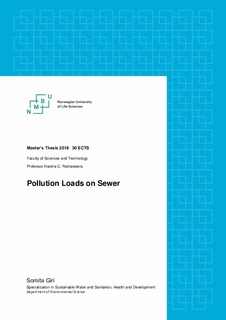| dc.description.abstract | The increasing water problems and environmental pollutions have been a crucial matter of interest due to its adverse impact on the human life and environment. The stringent environmental regulations thereby, are enforced by the concern authorities as a measure of environmental protection and sustainability. The objectives of this study are to analyze various sewer parameters manually using online and offline measurements, identify the correlation between sewer parameters from multivariate statistical tool (Unscrambler X), search for the innovative measurement concept based on time and cost effective correlated sewer parameters to estimate some expensive and slow responding sewer parameters. In addition, quantifying the pollutant loads in the sanitary sewage influent. Therefore, effective, efficient and optimal treatment of the wastewater along with the proper regulation of the environmental laws can be achieved.
A total 9 days 24-hour sewage sample series with the time interval of 1 hour, were collected by autosampler from January to April 2018. The sampling was done from the upstream separate sanitary sewer line at Våkas in Asker municipality. The global wastewater parameters pH, conductivity, total suspended solids, turbidity, Nitrate (NO3), Ammonium (NH4), Orthophosphate (PO4), Total phosphorus and COD were measured in the Laboratory at NMBU. The nutrients were measured from automated colorimeter, Systea EasyChem Plus. The flow data collected from the Regnbyge.no indicated 3 times increment in the average sewage flow rate during WWF (sewage flow rate higher than 0.02m3/s) in comparison to DWF. The high degree of infiltration into the sewer networks possibly from the nearby water stream and surface runoffs during rainfall and snowmelt events were observed. The pollutants concentration significantly reduced during wet weather due to the dilution of the dry weather sanitary sewage from infiltrated groundwater and surface runoffs. It was observed that the characteristics of influent wastewater varies temporally and are highly influenced by the characteristics and environmental exposures of the catchment area such as average rate of water supply (lpcd), population size and living style, climatic condition, seasonal variation and peak hours of day (morning and evening). With the average sewage flow rate of 0.027 ± 0.020 m3/s, average pollutant concentration in overall samples were found to be 8.399 ± 7.112 mg/l for ammonium, 1.275 ± 1.030 mg/l for nitrate, 165.340 ± 150.072mg/l for COD, 1.126 ± 1.069 mg/l for orthophosphate and 2.02 ± 1.882 mg/l for total phosphorus. The average pH, conductivity, turbidity and TSS measured in the laboratory were found to be 7.52 ± 0.534, 496.58 ± 65.5 µS/cm, 38.83 ± 37.57 NTU and 89.54 ± 79.31 mg/l respectively.
There is an urgent need of proper maintenance of the leaky sewer network system to prevent possible sewage overflow during wet weathers and high environmental contamination risks. From PCA, strong correlation between atmospheric temperature and sewage flow rate was observed which has inverse relation with another correlated group of parameters namely turbidity, TSS, nitrate, ammonium, orthophosphate, total phosphorus and conductivity. The highly correlated parameters that are easy, simple and fast to measure can be used to estimate slow responding and costly parameters such as COD, total phosphorus. This can save the energy and resources up to a great extent. Additionally, new innovative ideas for the virtual sensor development can be obtained from further multivariate statistical analysis. | nb_NO |

